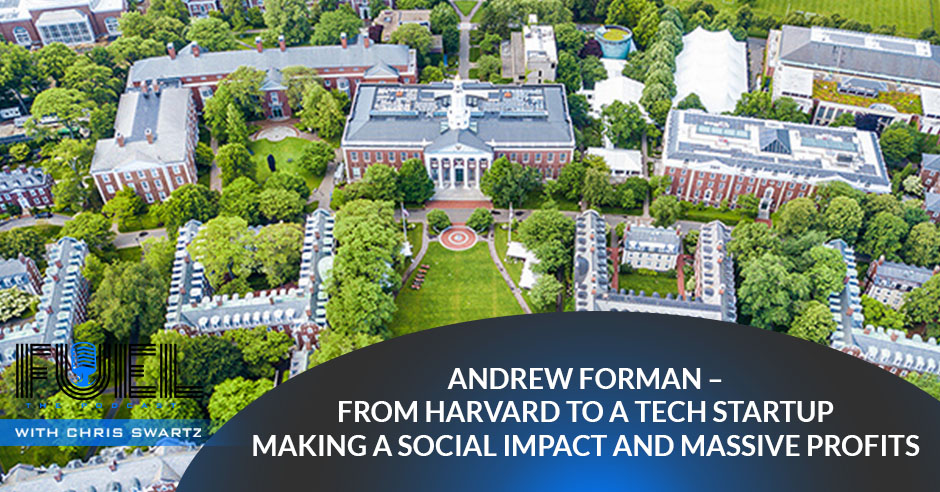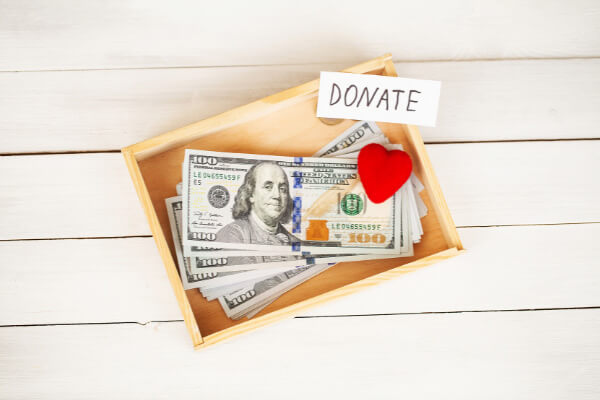
You can make an impact while still earning a profit. Andrew Forman does this every single day. Andrew is the founder and CEO of the tech startup, Givz. Givz lets you convert discounts into donations. This adds a very tangible value of purpose and meaning to every sale. Learn how he started his entrepreneurial journey and how he found his aha moment. Discover why discounts are going away and how making a social impact is the way. Join Chris Swartz as he talks to Andrew about his business and the impact he and his team is making in the world.
—
Listen to the podcast here
Andrew Forman – From Harvard To A Tech Startup Making A Social Impact And Massive Profits
I am here with Andrew Forman. Andrew, how are you
I’m doing well. Thanks. I’m happy to be here.
Thanks for reaching out and connecting with us. Andrew is the CEO of Givz. Why don’t you tell us a little bit about what you do at Givz and what your company is all about?
We’re helping brands shift $80 billion of discounts over to donations instead and drive a whole bunch more sales in the process. I can do the quick spiel here but I’m happy to talk about the journey as that’s what you are all about here on the show. On my side, we see two huge trends happening in eCommerce. First is that brands are trying to get away from discounts. They recognize that consumers brought in via discounts are the lowest lifetime value customers. How do we get away from discounting, not be in that discount bin but still drive short-term sales?
Secondarily, how do we weave in social impact genuinely and authentically? Separately but just as important, we need to form good connections with our customers. That’s where Givz comes in, allowing brands to run donation-based incentives and replace discounts with donations like spending over $100 and getting $20 to give to a charity of your choice. You’d go spend $100 at this brand and get $20 as a reward after you’ve made your purchase to give to any charity that you care about. That’s what we do here at Givz.
I love adding value as opposed to giving that discount but putting it to good use. That’s an awesome concept.
I appreciate it. I went to Hamilton undergrad where I did Math and Economics. I did six years of investment banking. People are thinking, “Investment banking, Harvard Business School and then charity, what stinks? What’s going on here?” The missing link for most people is that I was a treasurer of a nonprofit for five years while I was doing investment banking. I was trying to put my stamp of impact on the world while making money out of money doing investment banking. All of these were high-performance activities that we were trying to get off the ground.
Once I went back to business school, I said, “I want to do something that can truly do well and do good at the same time, something that a lot of people aspire to do.” I feel fortunate enough to have launched a company and tried to do something in a specific way as I saw the vision in my head. We pivot hard years ago into exactly what we do with brands but that’s not how it started. It’s been anything but a straight line to success.
If you have a nonprofit, know that consumers don't like payment friction. Click To TweetIt’s interesting how we map out our journey. The mortgage business that I was in was a small company. It’s just one of my previous employers and me. My background prior to mortgages is computer network engineering. I wired a little bit in that engineering mindset but he was truly an engineer. He went to MIT with you there at Harvard and Cambridge. He was wired with that engineering mindset. I don’t know how either one of us got into the mortgage business but we did. He was like, “Everything had to be that linear line and connect.” I’m like, “We are in the worst business for that.”
Business in general, you can’t take that linear line and say, “Here’s point A. We’re going to do this and get to point B.” Business in life doesn’t always follow that. As you started to go through your evolution of what you want to do, where did you figure out, “I want to give back but also start a company and be in this eCommerce space?” How did you marry the two? Where did that idea come from?
Way back when I was doing the nonprofit thing, I was also doing the investment bank thing. I worked at a boutique investment bank after my two years at a bulge bracket bank. I worked at a boutique investment bank and got some good experience working directly with CEOs of bigger growth businesses. One of the businesses that we covered was doing background screening checks in the Middle East. It was one of the most profitable companies that we had ever come across.
They were legitimately saving lives because they were catching people that were lying about being doctors, pilots or engineers and building buildings. They were quite saving lives and making a ton of money while doing it. I thought that was the coolest thing. I was like, “I would love to start a business that makes a ton of money and saves lives while doing it or at least does some good in the world while doing it. That is cool.”
I went back to business school thinking that I would join a company that does something like that. I needed both sides of it. To be clear, I wasn’t a fully bleeding heart like I want to have an impact and that’s it. I wanted to make a bunch of money and have an impact. I wanted the business to be able to sustain itself because as a nonprofit treasurer where we couldn’t sustain ourselves, other than asking people for money, I believed in the cause that we were building but at the end of the day, every donation dollar mattered so much.
I was a treasurer asking friends and family to support the mission that we had. It was a good mission. We raised a nominal amount at the end of the day each year to cover our expenses. That was not sustainable but the cause was great. When I’m in that business school, I’m trying to think, “What can I do? What kind of company can I join that will have this doing well, doing good component to it? I want both. Where am I going to find that?”
Did you not find that in the investment banking world?
I couldn’t. That’s why I went back to business school. At business school, they ask you, “What are you going to do with this one in precious life?” I see that over and over again. What was crazy drawing on my experience from being the treasurer of a nonprofit and having people donate to our nonprofit was one, consumers didn’t like the payment friction. They were Venmo-ing me instead of using our website where you can type in a credit card. They were like, “No, that’s too annoying. I’m going to Venmo you.” I was like, “Please don’t do that.” There are all sorts of stuff but they’re like, “Do you want the money or not?” Venmo and I have to figure it out from there.

Tech Startup: Two huge trends in eCommerce right now are that brands are getting away
from discounts. Consumers brought in via discounts are the lowest lifetime-value customers. The other
one is authentic social impact.
There was that whole piece of it with the payment friction side. I had a couple of corporate sponsorships that we were trying to create. At the end of the day, there was so much red tape trying to get a sponsor to either donate a certain amount of money or run some cause marketing campaign. I saw it from the other side, the flip side and the charity side how hard it was for a company like Athleta or any type of company to say, “We want to support you. I do. Let me run up the chain and try to figure it out.” The bigger the brands got, the harder it is to make stuff like that happen when it should be an absolute no-brainer.
The brand aligns with exactly what we’re doing. We should be able to audience share. If we said, “Athleta is doing something with us,” that would be 10,000 people that are engaged that should go shop at Athleta because of this. The match was there to be made but there was red tape and legal agreements that blew my mind as to how tough it was to make that connection. What we ended up doing in the first iteration was trying to solve that payment friction piece. My first idea was, “If we get all the donors in one place, we will have a billion-dollar company. Why don’t we build a Venmo for charity? That will eliminate the friction.”
What we didn’t anticipate was the first-time people used it, it still had that payment friction. You have to put in your credit card one time. We were trying to figure out what to do with the business from here. We had 3,000 early adopters that were donating more than they ever have before loving the experience but the a-ha moment hadn’t kicked in yet. When two brands came to me and said, “I’d love to replace our discount and instead give people credit on your Venmo for charity platform to donate,” I said that “That’s it. That’s going to work.”
That’s the a-ha moment. They did that. That was years ago and we never looked back. We got the results from that. Even before the results came, I knew they were going to be interesting. When they came back, they A/B tested the donation piece. One A/B test on Facebook and another brand A/B test via email. The donation piece performed 20% better than the discount piece. That was all I needed to say, “This is what we do. Let’s build a product around this.”
I was the President of a Rotary club, which I was in for ten years. I’m familiar on a little micro-scale in my community being in that nonprofit and grind trying to want to do good. There are other business owners in there trying to do business and say, “Let’s marry the two.” That fundraising, “I want to do good,” is harder than any job out there. It’s a thankless job. Kudos to you for figuring out the formula on how to marry the two.
We’re excited. We want to make it. This is a 2020 vision looking backwards but it’s funny that I ended up here after these years of trying to make it aligned with who you are as a person. For me, I always knew that it had to be. You need to make money to sustain the good that you want to do. For us, the pitch to brands is like, “You end up doing good in the process but do you want to make more money? You want to have 20% better conversion.”
I have an older daughter heading to college. That’s one of the things I try to instill because I feel like the younger generation only wants to do good, get behind a cause and make an impact. I’m trying to teach my daughter, “You can do that but also do that and make money because if you do that and make money, you’re going to need to make an impact.”
I always try to show her that money isn’t bad. That’s a key point. For people reading, it’s like, “It’s okay to want to make money. It makes life comfortable. If you want to have an impact, you’re going to need money to support your cause.” The fact that people attribute money to greed or people that want more money or want to make a lot of profit to capitalism and greed, maybe that exists but some people want money because it’s our currency and it makes things easier and more comfortable. It’s not right or wrong.
Align your business with who you are as a person. Click To TweetThe two can coexist. That’s the big piece here. They don’t have to be at odds with each other. Just because you make money does not mean that you can’t do good. You could always do more good. Take the money you earned, donate it and have it even be better but at the same time, it needs to be sustainable. At some point, if you’re donating every single dollar that you make, you’re not going to live a fruitful life to the point where you’re not going to be able to make enough money. It’s a small piece of a larger pie type of argument.
Shifting gears a little bit, there’s an interesting Dan Pallotta’s TED Talk on this that I’m obsessed with from ages ago where he talks about charity and debunking this overhead myth of charities where people get upset about, “I donated $10 and they used it for advertising to get more money. I don’t want them to use it for advertising. I want them to use it for the program that I donate it to.”
Let’s say it was brain cancer research and they had $100,000. They put all $100,000 into brain cancer research and then they run out of money and that’s it or they could take that $100,000 and use $20,000 of it for advertising to bring in another $200,000. They spent $20,000 on advertising but have $280,000 to spend on brain cancer research instead of $100,000. There’s a nuance there that you have to understand.
That’s an interesting point of view because people think, “You’re taking my money and soliciting to get more money.” It comes back to that same principle. You need money to make an impact. Right or wrong, that’s the reality. It doesn’t happen. If you don’t have it, you’re going to be pounding the phones or soliciting donations from somebody somewhere to push your cause forward. One of the other things too that we talk about is what I noticed in what you sent over surrounding yourself with people. I always tell people that there’s the currency that we need and the money but then there’s the human capital, aligning with the right people.
It’s something that I feel like whether it’s in business or personal life, at the end of the day, the people you surround yourself with are important. You do control a lot more of that than you think. As you parse out some of these motivational speakers and such where they’re talking about surrounding yourself with the five people that you want to be because you’re a conglomerate of those five people, I’m not sure I go to that extreme. I was so ingrained in the finance world and spent six years of investment banking. You’re in that realm. I was like, “I want to see what else is out there.”
I couldn’t go from investment banking to the entrepreneur side. My wife was an entrepreneur turned venture capitalist. She was in that startup world. I wanted to make an impact. I had the nonprofit community on the impact side. Trying to figure out who we were spending time with and what we ultimately want to do was important. That only became 10X more important when I started the company and realized that the people that you surround yourself with inside the company make or break whether you’re going to be successful or not. The idea almost doesn’t matter.
I’ve experienced that myself. Some of the five people in the circle you want to keep around because they’re fun but they might not be the ones that are going to level you up. There’s that balance. You want to surround yourself with good people but you don’t have to be fanatical. “If you don’t fit, you’re out.”
“I heard Andrew on a podcast. That’s it, you’re gone.” No. I do also think if there’s somebody that you’ve got a relationship with for twenty years who’s always bringing you down and it’s annoying, then get rid of them. You can do that.

Tech Startup: You can always do more good by donating your money but at the same
time, it needs to be sustainable. If you’re donating every single dollar that you make,you’re not
going to live a fruitful life.
Where’s the future for your vision? One thing I want to talk about is vision. A lot of people reading may have a vision of starting a business like, “How do we do it? Where do we go?” Talk about having the vision and then executing it to the point where it becomes a reality.
For me on the Givz side of things, Givz is my work baby. I have two children. Nothing compares to that. On the professional side, the vision is extremely important. Where do I see this years from now? I do see Givz as the infrastructure allowing brands to make financially positive decisions to donate a ton of money. I want billions of dollars flowing through our pipes that allow consumers. There are multiple touchpoints such as the brands, charities and consumers. We’re going to sit at the center of that triangle, allowing money to flow in a GDP positive way, where people are saying, “This is cool. I’m shopping from brands that care so much about me as an individual.”
The brand is giving me $10 after I purchased. They’re not asking me for $0.47 extra to round up my donation. They’re not asking me when I’m standing in line at a store, “Do you want to donate an extra $1, $3 or $5 to this cause?” I’m like, “It depends on how bad I feel about everybody watching me.” They’re not trying to guilt me into anything. They are saying, “Thank you for shopping with us. As a valued customer, here are $5, $10 and $20 to give to any charity that you want.” As a consumer, there are knock-on effects here that I very rarely talk about because there’s too much to talk about.
Especially to brands, I’m like, “At the end of the day, that motivating factor is going to act like a discount.” For Gen Z, it performs better than a discount and discussion. I have to stop talking at that point. For me, as I think about the vision, the fact that consumer has to think about, “I have $20 that I can give to any charity that I want. What charity do I want to support,” there’s a knock-on positive effect there for the world where some people don’t have $20 to give.
This is going to be the first time that they’re donating $20 to a charity and they’re like, “Who should I support?” Then they’re like, “I’m in the driver’s seat. I get to think about this. Do I care about the environment, the animals or the local hospital here? What is it that I care about?” That is an exciting thing for me.
You mentioned Gen Z. Are you finding consumers, in general, to be receptive to this? Nothing against our Gen Z readers but we’re passionate about supporting a social cause.
The Millennial generation was initially the discount generation and even the parents of the Millennials. I would consider myself an elder Millennial and then the generation above us. We were discount heavy back in the early days of this like, “I’m getting a deal, a discount and that’s it.” Our parents and even Millennials have a bit more money and they’re saying to themselves, “I’ll pay $10 extra. Maybe I have kids of my own, I want a better world for them. If I can purchase from a brand that’s a little bit more expensive, potentially higher quality but also cares about what I care about, I’m going to do that.” This is not like, “This other brand doesn’t make their stuff sustainably at all but it’s $10 cheaper. I’m going to buy that.” That’s on the outs across generations.
That’s a good thing because it does align with that service-based contribution. You’re driving the business forward. Ultimately, that’s what fills this country. I love the mission. On a note, you do have two little ones too. You’re in the trenches.
There are multiple touchpoints: the brands, the charities, and the consumers. Try to sit in the center of that triangle. Click To TweetI have a daughter and a son. I feel very fortunate to have two happy, healthy babies but it is pandemonium in our house, with starting a business, having the two little ones and knowing how important family is. To me, getting to spend that time with the kids and carving out that time saying, “I’m not going to answer emails from 6:00 PM to 8:30 PM when my oldest goes to sleep.” That is phone away time and two and a half hours every day that I’m going to spend with those kids or waking up early with the little one and spending time with him. It’s a grind. There’s no way around it.
For anybody else that has young kids, it’s important to carve out that time. That time looks different for everybody. If you can carve out 2 hours, 1 hour or 10 minutes, you’ll be surprised when you look back later in life on how special that little bit of time is. A lot of our readers are grinding. You’re trying to start a business and take it to the next level. In sports, you’re practicing. You’re putting in all the time and the work but don’t get lost.
If you don’t have kids, invest a couple of extra minutes to call your parents and friends. Put a little something out there and invest that time. Don’t get so caught up in building the business because everybody says it’s so cliche but life goes by so fast. As an entrepreneur, it goes by even faster because there’s always something to do. I’ve talked about this all the time on the show. Nothing against us but it’s not how I’m wired.
It’d be cool to come home one day and be like, “It’s 5:00. Nobody’s going to call me. My job is done. I’m going to kick off my shoes and watch the ball game.” I’m always thinking about the next thing like, “That’d be a cool science experiment to give me a pill or something and pretend I have a 9:00 to 5:00. I want to experience that for a day.”
I feel like the grass is always a greener type of deal but it’s always interesting to think about once you go down the entrepreneurial journey, there’s no such thing. Even if you stop working at 5:00 and say, “I’m not going to work again until 9:00 the next morning,” your mind never stops thinking. You’d need some sort of pill.
Andrew, it’s been so great to have you on the show. I’m glad we connected. One of the awesome things about the show is being able to connect randomly with people around the world that have a common goal and mission to do good, achieve great things and make an impact. We only have a finite number of days on this planet here. I love the message that you can make an impact and a massive profit. It’s cool and neat.
I’m excited to see social media and online eCommerce continue to explode. I’m sure you have ample opportunities to make tons of cash just as important to make that impact that you want on the world. Thank you so much for jumping on the show and sharing your journey. If someone wants to connect with you, how can they find you or get in touch with you to learn more about Givz or in general?
First of all, thanks so much for having me on. It’s been an absolute pleasure. I loved the show. On my side, you can always find us. Givz.com. On Instagram and Twitter, on LinkedIn as well. We’re very active. It’s always @GetGivz on Instagram and Twitter. @Givz on LinkedIn. My personal is at @AForman22 on Twitter. DMs are open. Andrew Forman on LinkedIn. You should be able to find me.

Tech Startup: Once you go down the entrepreneurial journey, there’s no such thing as stopping.
Even if you stop working at five and say, you’re not working until nine, you’re still going
to work the next morning.
I look forward to keeping in touch. Before we let you go, we’re going to, in true FUEL fashion, hit you with our Rapid-fire three quick questions. It’s simple, easy and fun. Don’t overthink it. The first question is about the whole scenario here. You’re stuck on an island and not getting off the island. We know you would take your family, friends and all your loved ones but outside of that, who would you take with you? Family and friends are excluded.
The first thing that comes to mind is if we’re stuck on this island, we’re going to need a ton of stories. I read Matthew McConaughey’s Greenlights book, which was hilarious and interesting. He has a lot of stories to tell that could last a long time and in terms of entertainment value. I would not want to be stuck on an island forever.
Second, what’s a book that you’ve read that you’d like to share with our readers that’s had an impact on your life?
It’s The Hard Thing About Hard Things. I’m sure you are familiar with it or not. It’s by Ben Horowitz and Andreessen Horowitz. It’s true and hard.
I haven’t heard of that one.
Check that out. It’s on the list of entrepreneur books to be read. I re-read that one. There’s the hard stuff that you have to do and the sacrifice that you have to make. It’s hard.
I’ll check that out. The last one’s easy. What’s your favorite food guilty pleasure? What do you have to have on the island with you?
I don’t know that I’d bring the hard thing about hard things onto the island because that would be depressing. I will bring something happier. In terms of if we’re still on the island, for me it would be chicken parmigiana. If I gave an upgrade to the side of pasta, Penne Alla Vodka, then we’re in great shape.
Everyone out there, I hope you enjoyed the show. If you got something out of this, share it on social media and with your friends and family. Give us a five-star rating on iTunes. On that note, we’re out.
Important Links
- Givz
- Dan Pallotta’s TED Talk
- @GetGivz – Instagram
- Twitter – Givz
- @Givz – LinkedIn
- @AForman22 – Twitter
- Andrew Forman – LinkedIn
- Greenlights
- The Hard Thing About Hard Things
- iTunes – FUEL with Chris Swartz
About Andrew Forman
 I’m Andrew the CEO & co-founder of Givz. We help Shopify merchants use donation incentives vs. discounts. If you’re ready to detox from the ‘discount drug’, check out our Givz playbook and feel free to DM me directly: https://givz.com/optimal-playz/
I’m Andrew the CEO & co-founder of Givz. We help Shopify merchants use donation incentives vs. discounts. If you’re ready to detox from the ‘discount drug’, check out our Givz playbook and feel free to DM me directly: https://givz.com/optimal-playz/
Tags: Charity Donation, Discounts, eCommerce, Making Impact, Time Management, Vision
